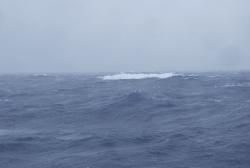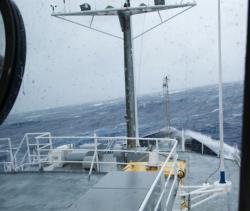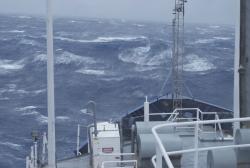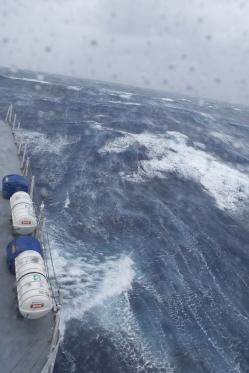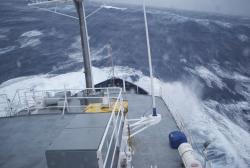Alison MacdonaldI hope you have read Karen’s description of what is was like for her, as a watch stander to wake up to her shift in the middle of storm. This is the chief scientist perspective, the beginning taken from a letter I wrote to a friend during the height of the storm for us on Friday. Dear Jane, Well, all our beautiful blue, so calm you could see the rosette at 28m - waters are gone. We now have 50+ kt winds from a storm-heading straight along our track. No one's been allowed out on deck since yesterday afternoon except for necessary work (like trying to save the boxes of equipment spares). We managed to get the rosette on board at about 6pm last night (it been in the water since 10 in the morning), but part of the track has been broken and will have to be welded, and we will have to re-terminate before going back in (whenever that may be). Looks like we will be skipping stations right and left if we are going to get to Tahiti on time (which we are). I shutdown my laptop last night, left it closed and tied down, but when I turned it on this morning I found the screen as cracked. Luckily, I have the other monitor. I am backing things up, but I hope it makes to end of the cruise. There are now exactly three people in the main lab and two of them are watching movies. We should be planning a Christmas entertainment, but I think we are all too tired to even think about it. Nevertheless, I believe we are mostly in good spirits, and this will give everyone a chance to (back and forth, back and forth....holding on) get some sleep, if that is possible. - Alison This storm has been a learning experience for me as chief scientist, not because I have never been in a ship at sea in bad weather, I have, but because I have never been in charge of decisions concerning our track and deployment in such instances. As Karen said, it was exciting, like a blizzard when you are home or a hurricane that doesn’t quite hit. It was inconvenient when we could no longer use the washing machine, when the coffee maker broke, when it caused our equipment to fail. And, it was downright scary when everything in the lab tipped first in one direction and then the other, when people fell out chairs even when they are tied down, when filing cabinets and printers broke their ties to come crashing to the floor, when glassware smashed, fresh water from chemical bath splashed across the work benches and computers, and salt water from waves hitting the deck came sloshing through locked doors. Dave (chief engineer) in trying to explain how high the waves were to his daughter said they are so high that when you go up a wave the boat tips so that all you can see is sky. On Friday when I came on shift we put the package in the water and found that we could lower it as long as we didn’t exceed 20 m/min because the tension on the wire was bouncing from 0 to 4000 lbs. But, at that rate instead of taking the usual hour and half to get down to the bottom (5665 m), it took us 4 to go down and another 3 to come back up. So, it was well past the end of my shift when it was brought out of the water. Jack took the slide show of pictures. The two of us were on the bridge watching; me without my camera because I was more concerned with the safety of the recovery team and the rosette than I was with pictures. Of course, after the fact, I was glad he was up there with his camera. Richard who works as a cook in the galley took the movie. What the pictures can’t show you, and the movie does a little, is how hard the wind was blowing, how violently the waves were rocking the ship, how hard Eric was trying to bring the rosette back to a straight up and down vertical position in front of the team standing at starboard Aframe so they could grab it, and how hard it swung when they caught it. A few things to notice: how far out Keith in leaning with his hook; the fact that three hooks are being used instead of two; can you see what happens to that third hook, it fell out of the pole and had to be reeled back in, Keith leans out again to grab the rosette with it. The wire became bent in two places on this recovery. Yesterday I learned how to do the re-termination necessary to take the kinks out by moving the connection with the rosette further up the wire. See the yellow platform the rosette is sitting on. It runs on a track that is bolted to the deck. A wave took inside of the track and ripped it out of the deck by breaking the metal tags that held it down. The air conditioner in the Helium-Tritium van was also hit by a wave and we can no longer do Helium analysis. We are working on getting a new air conditioning unit in Tahiti. So here we were a day later, the winds still at 40 kts. We took a dog-leg south going less than 3 kts., to try to get a smoother ride. I decided to skip the next station completely. It was well past my shift and I had to decide what to do. As we had already been a day behind, we were now at least two and half days behind and likely more. Would the weather change while I was asleep? We were heading east (the storm was heading east at 5 kts – so even if we got in front, it would catch up). I told the captain we would wait on station until Keith felt comfortable putting the package in the water again. Shenfu and I did a quick calculation and summarily removed half of the planned stations still ahead of us. The next morning we are still rocking and rolling, but the package is in the water. We have just finished station 100. In celebration we are watching the 1976 version of King Kong staring Jessica Lange as Dwan and the R/V Melville as the Petrox Explorer. The seas are blue. The wind is blowing, but just enough to make us notice. The storm turned southeast off our track. Whew. On to station 101. Last updated: December 26, 2009 | |||||||||||||||||||||
Copyright ©2007 Woods Hole Oceanographic Institution, All Rights Reserved, Privacy Policy. | |||||||||||||||||||||
